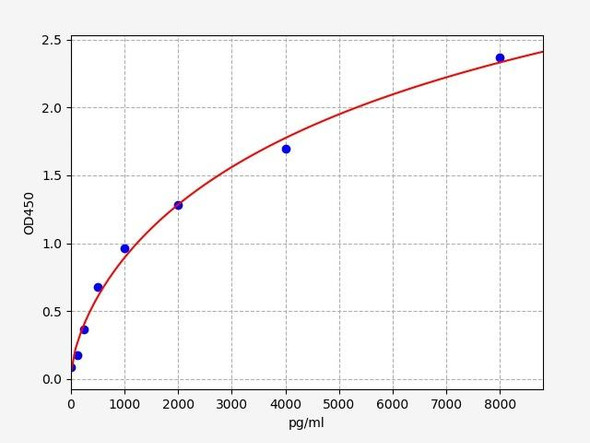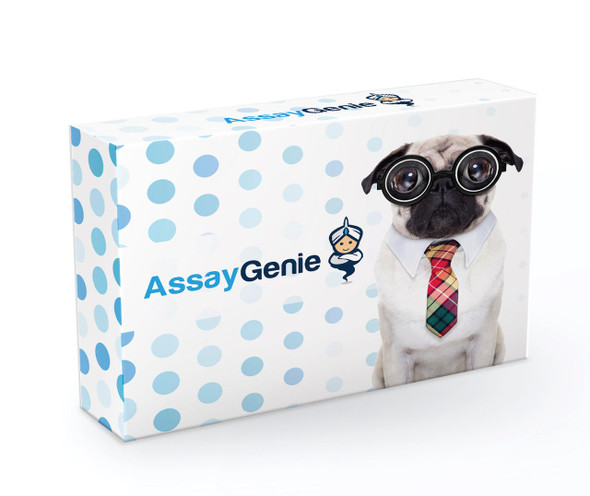Mouse HIF-2 alpha (Hypoxia Inducible Factor 2 Alpha) ELISA Kit (MOES01264)
- SKU:
- MOES01264
- Product Type:
- ELISA Kit
- Size:
- 96 Assays
- Uniprot:
- P97481
- Sensitivity:
- 0.19ng/mL
- Range:
- 0.31-20ng/mL
- ELISA Type:
- Sandwich
- Reactivity:
- Mouse
- Sample Type:
- Serum, plasma and other biological fluids
- Research Area:
- Cardiovascular
Description
Mouse HIF-2 alpha (Hypoxia Inducible Factor 2 Alpha) ELISA Kit
The Mouse HIF-2 Alpha (Hypoxia-Inducible Factor 2 Alpha) ELISA Kit is a reliable tool for the quantitative measurement of HIF-2 Alpha levels in mouse samples such as serum, plasma, and cell culture supernatants. With its high sensitivity and specificity, this kit ensures accurate and reproducible results, making it suitable for various research applications.HIF-2 Alpha is a key transcription factor that plays a critical role in the cellular response to hypoxia, regulating genes involved in processes like angiogenesis, erythropoiesis, and metabolism.
Dysregulation of HIF-2 Alpha has been implicated in diseases such as cancer, cardiovascular disorders, and pulmonary hypertension, highlighting its importance as a biomarker for studying these conditions and developing therapeutic interventions.Overall, the Mouse HIF-2 Alpha ELISA Kit from Assay Genie provides researchers with a valuable tool for investigating the role of HIF-2 Alpha in various physiological and pathological processes in mouse models.
| Assay type: | Sandwich |
| Format: | 96T |
| Assay time: | 4.5h |
| Reactivity: | Mouse |
| Detection Method: | Colormetric |
| Detection Range: | 0.31-20 ng/mL |
| Sensitivity: | 0.19 ng/mL |
| Sample Volume Required Per Well: | 100µL |
| Sample Type: | Serum, plasma and other biological fluids |
| Specificity: | This kit recognizes Mouse HIF-2 alpha in samples. No significant cross-reactivity or interference between Mouse HIF-2 alpha and analogues was observed. |
This ELISA kit uses Sandwich-ELISA as the method. The micro ELISA plate provided in this kit has been pre-coated with an antibody specific to Mouse HIF-2 alpha. Standards or samples are added to the appropriate micro ELISA plate wells and combined with the specific antibody. Then a biotinylated detection antibody specific for Mouse HIF-2 alpha and Avidin-Horseradish Peroxidase (HRP) conjugate are added to each micro plate well successively and incubated. Free components are washed away. The substrate solution is added to each well. Only those wells that contain Mouse HIF-2 alpha, biotinylated detection antibody and Avidin-HRP conjugate will appear blue in color. The enzyme-substrate reaction is terminated by adding Stop Solution and the color turns yellow. The optical density (OD) is measured spectrophotometrically at a wavelength of 450 nm ± 2 nm. The OD value is proportional to the concentration of Mouse HIF-2 alpha. The concentration of Mouse HIF-2 alpha in samples can be calculated by comparing the OD of the samples to the standard curve.
| UniProt Protein Function: | HIF2A: Transcription factor involved in the induction of oxygen regulated genes. Binds to core DNA sequence 5'-[AG]CGTG-3' within the hypoxia response element (HRE) of target gene promoters. Regulates the vascular endothelial growth factor (VEGF) expression and seems to be implicated in the development of blood vessels and the tubular system of lung. May also play a role in the formation of the endothelium that gives rise to the blood brain barrier. Potent activator of the Tie-2 tyrosine kinase expression. Activation seems to require recruitment of transcriptional coactivators such as CREBPB and probably EP300. Interaction with redox regulatory protein APEX seems to activate CTAD. Efficient DNA binding requires dimerization with another bHLH protein. Heterodimerizes with ARNT. Interacts with CREBBP. Interacts with EGLN1. Interacts with VHL. Expressed in most tissues, with highest levels in placenta, lung and heart. Selectively expressed in endothelial cells. |
| UniProt Protein Details: | Protein type:Transcription factor; DNA-binding Cellular Component: cytoplasm; nuclear speck; nucleus; transcription factor complex Molecular Function:cobalt ion binding; DNA binding; histone acetyltransferase binding; protein binding; protein heterodimerization activity; sequence-specific DNA binding; transcription factor activity; transcription factor binding Biological Process: angiogenesis; blood vessel remodeling; cell differentiation; cell maturation; embryonic placenta development; erythrocyte differentiation; hemopoiesis; iron ion homeostasis; lung development; mitochondrion organization and biogenesis; myoblast cell fate commitment; negative regulation of transcription from RNA polymerase II promoter; norepinephrine biosynthetic process; norepinephrine metabolic process; positive regulation of transcription from RNA polymerase II promoter; regulation of heart rate; regulation of transcription from RNA polymerase II promoter in response to oxidative stress; response to hypoxia; response to oxidative stress; surfactant homeostasis; visual perception |
| UniProt Code: | P97481 |
| NCBI GenInfo Identifier: | 3914285 |
| NCBI Gene ID: | 13819 |
| NCBI Accession: | P97481. 2 |
| UniProt Secondary Accession: | P97481,O08787, O55046, |
| UniProt Related Accession: | P97481 |
| Molecular Weight: | 96,712 Da |
| NCBI Full Name: | Endothelial PAS domain-containing protein 1 |
| NCBI Synonym Full Names: | endothelial PAS domain protein 1 |
| NCBI Official Symbol: | Epas1 |
| NCBI Official Synonym Symbols: | HLF; HRF; MOP2; HIF2A; bHLHe73; HIF-2alpha |
| NCBI Protein Information: | endothelial PAS domain-containing protein 1 |
| UniProt Protein Name: | Endothelial PAS domain-containing protein 1 |
| UniProt Synonym Protein Names: | HIF-1-alpha-like factor; HLF; mHLF; HIF-related factor; HRF; Hypoxia-inducible factor 2-alpha; HIF-2-alpha; HIF2-alpha |
| Protein Family: | Endothelial PAS domain-containing protein |
| UniProt Gene Name: | Epas1 |
| UniProt Entry Name: | EPAS1_MOUSE |
As the OD values of the standard curve may vary according to the conditions of the actual assay performance (e. g. operator, pipetting technique, washing technique or temperature effects), the operator should establish a standard curve for each test. Typical standard curve and data is provided below for reference only.
| Concentration (ng/mL) | O.D | Average | Corrected |
| 20 | 2.333 2.351 | 2.342 | 2.271 |
| 10 | 1.575 1.579 | 1.577 | 1.506 |
| 5 | 0.886 0.87 | 0.878 | 0.807 |
| 2.5 | 0.435 0.453 | 0.444 | 0.373 |
| 1.25 | 0.251 0.225 | 0.238 | 0.167 |
| 0.63 | 0.172 0.154 | 0.163 | 0.092 |
| 0.31 | 0.115 0.121 | 0.118 | 0.047 |
| 0 | 0.069 0.073 | 0.071 | -- |
Precision
Intra-assay Precision (Precision within an assay): 3 samples with low, mid range and high level Mouse HIF-2 alpha were tested 20 times on one plate, respectively.
Inter-assay Precision (Precision between assays): 3 samples with low, mid range and high level Mouse HIF-2 alpha were tested on 3 different plates, 20 replicates in each plate.
| Intra-assay Precision | Inter-assay Precision | |||||
| Sample | 1 | 2 | 3 | 1 | 2 | 3 |
| n | 20 | 20 | 20 | 20 | 20 | 20 |
| Mean (ng/mL) | 0.91 | 3.06 | 8.16 | 0.92 | 2.92 | 8.29 |
| Standard deviation | 0.06 | 0.15 | 0.45 | 0.05 | 0.13 | 0.32 |
| C V (%) | 6.59 | 4.90 | 5.51 | 5.43 | 4.45 | 3.86 |
Recovery
The recovery of Mouse HIF-2 alpha spiked at three different levels in samples throughout the range of the assay was evaluated in various matrices.
| Sample Type | Range (%) | Average Recovery (%) |
| Serum (n=5) | 88-99 | 94 |
| EDTA plasma (n=5) | 96-107 | 101 |
| Cell culture media (n=5) | 85-96 | 91 |
Linearity
Samples were spiked with high concentrations of Mouse HIF-2 alpha and diluted with Reference Standard & Sample Diluent to produce samples with values within the range of the assay.
| Serum (n=5) | EDTA plasma (n=5) | Cell culture media (n=5) | ||
| 1:2 | Range (%) | 93-104 | 90-103 | 86-101 |
| Average (%) | 99 | 96 | 93 | |
| 1:4 | Range (%) | 90-104 | 84-99 | 88-100 |
| Average (%) | 97 | 91 | 94 | |
| 1:8 | Range (%) | 92-103 | 82-96 | 83-93 |
| Average (%) | 97 | 89 | 88 | |
| 1:16 | Range (%) | 93-109 | 82-92 | 83-96 |
| Average (%) | 100 | 87 | 88 |
An unopened kit can be stored at 4°C for 1 month. If the kit is not used within 1 month, store the items separately according to the following conditions once the kit is received.
| Item | Specifications | Storage |
| Micro ELISA Plate(Dismountable) | 8 wells ×12 strips | -20°C, 6 months |
| Reference Standard | 2 vials | |
| Concentrated Biotinylated Detection Ab (100×) | 1 vial, 120 µL | |
| Concentrated HRP Conjugate (100×) | 1 vial, 120 µL | -20°C(shading light), 6 months |
| Reference Standard & Sample Diluent | 1 vial, 20 mL | 4°C, 6 months |
| Biotinylated Detection Ab Diluent | 1 vial, 14 mL | |
| HRP Conjugate Diluent | 1 vial, 14 mL | |
| Concentrated Wash Buffer (25×) | 1 vial, 30 mL | |
| Substrate Reagent | 1 vial, 10 mL | 4°C(shading light) |
| Stop Solution | 1 vial, 10 mL | 4°C |
| Plate Sealer | 5 pieces | |
| Product Description | 1 copy | |
| Certificate of Analysis | 1 copy |
- Set standard, test sample and control (zero) wells on the pre-coated plate and record theirpositions. It is recommended to measure each standard and sample in duplicate. Note: addall solutions to the bottom of the plate wells while avoiding contact with the well walls. Ensuresolutions do not foam when adding to the wells.
- Aliquot 100µl of standard solutions into the standard wells.
- Add 100µl of Sample / Standard dilution buffer into the control (zero) well.
- Add 100µl of properly diluted sample (serum, plasma, tissue homogenates and otherbiological fluids) into test sample wells.
- Cover the plate with the sealer provided in the kit and incubate for 90 min at 37°C.
- Aspirate the liquid from each well, do not wash. Immediately add 100µL of BiotinylatedDetection Ab working solution to each well. Cover the plate with a plate seal and gently mix. Incubate for 1 hour at 37°C.
- Aspirate or decant the solution from the plate and add 350µL of wash buffer to each welland incubate for 1-2 minutes at room temperature. Aspirate the solution from each well andclap the plate on absorbent filter paper to dry. Repeat this process 3 times. Note: a microplatewasher can be used in this step and other wash steps.
- Add 100µL of HRP Conjugate working solution to each well. Cover with a plate seal andincubate for 30 min at 37°C.
- Aspirate or decant the solution from each well. Repeat the wash process for five times asconducted in step 7.
- Add 90µL of Substrate Reagent to each well. Cover with a new plate seal and incubate forapproximately 15 min at 37°C. Protect the plate from light. Note: the reaction time can beshortened or extended according to the actual color change, but not by more than 30min.
- Add 50 µL of Stop Solution to each well. Note: Adding the stop solution should be done inthe same order as the substrate solution.
- Determine the optical density (OD value) of each well immediately with a microplate readerset at 450 nm.







